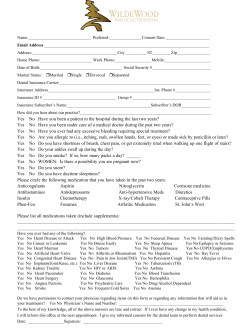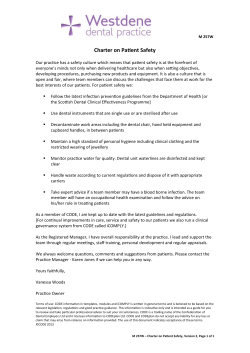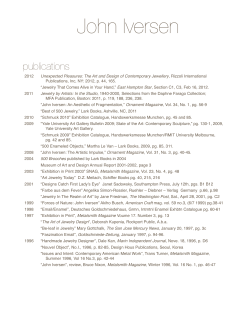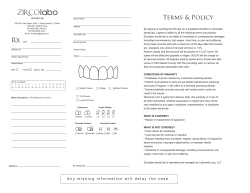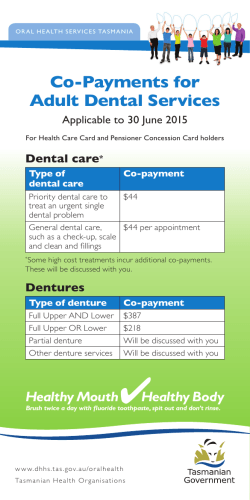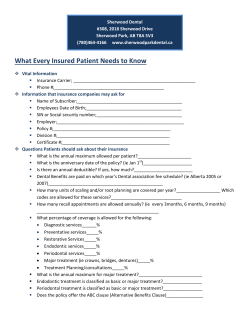
a study in the journal General Dentistry
Operative Dentistry Dissolution of dental enamel in soft drinks J. Anthony von Fraunhofer, MSc, PhD, FADM, FRSC | Matthew M. Rogers, DDS A high percentage of the population consumes a variety of soft drinks on a daily basis. Many of these soft drinks contain sugar and various additives and have a low pH. This study compares enamel dissolution from both regular and diet beverages. Received: February 25, 2004 The consumption of soft drinks has increased dramatically over past several decades; the soft drink industry is reported to produce 10 billion 192-ounce cases per year.1 Over a 50-year period, annual soft drink production appears to have increased fivefold, from 100 12-ounce cans per person in 1947 to nearly 600 12ounce cans per person in 1997. Looking at it another way, the average person in 1947 consumed approximately two cans of soft drinks per week, while the average person in 1997 consumed approximately 12 cans of soft drinks per week, or nearly two cans per day. The greatest increase in soft drink consumption has occurred among children and adolescents; nearly 40% of preschool children drink more than 250 mL (8.0 ounces) of soft drinks per day.2 The average consumption of soft drinks in the U.S. in 2002 was approximately 53 gallons per year, or 16 ounces per day, which represents 24% of the recommended daily fluid intake of 67 ounces.3 Although no distinction is made between regular and diet soft drinks, recent figures (examining the period from 1994–1996) indicate that soft drink consumption among 12-to-19-year-old boys is 28 ounces (800 mL) per day; among 12-to19-year-old girls, the rate of consumption is 21 ounces (600 mL) per day.4 In recent years, diet (that is, reducedcalorie) versions of popular drinks have increased in relation to their regular beverage counterparts (that is, those containing sucrose or fructose). In 1997, artificially-sweetened diet sodas accounted for 24% of soft-drink sales, an increase of 16% since 1970.5 There also is a growing trend within North America (and perhaps throughout the developed world) toward increased consumption of noncola drinks and nontraditional beverages (for example, pre-packaged coffees and 308 General Dentistry Accepted: March 29, 2004 teas).1 There also has been an upward trend in the consumption of sports drinks, although these may have a sugar content as high as 20%.1 Anecdotal reports of rampant dental caries related to frequent consumption of soft drinks are increasingly common.1 In 2002, a young man who consumed three to four 32-ounce beverages per day while working at a computer terminal reported a case of rampant dental decay.6 The induction of dental caries by refined sugars is well-established, although prevalence is affected by numerous factors, including the foodstuff ’s cariogenicity and frequency of ingestion, the oral levels of cariogenic bacteria (for example, Streptococcus mutans), water fluoridation, frequency of toothbrushing and dentifrice use, general dietary variables, and the inherent variability in oral physiology. Ideally, the pH of saliva lies within the range of 5.5–6.5; a pH of 5.5 generally is accepted as the threshold level for the development of dental caries.7 While the oral cavity may recover when the pH within the oral cavity drops below this threshold, prolonged exposure to this pH or frequent cycling from the optimal (that is, neutral) pH to a value below the threshold can result in a more rapid demineralization of enamel. Lowered salivary pH often is a consequence of bacterial digestion of sucrose, fructose, and similar carbohydrates, causing acidic byproducts to form in dental plaque. Tooth demineralization, however, also may occur due to dental erosion. Dental erosion is the irreversible, usually painless, loss of dental hard tissue that occurs due to a chemical process, such as dissolution or chelation, without the involvement of micro-organisms.1,9-13 Although susceptibility to dental erosion varies among individuals due to such fac- www.agd.org tors as pH, salivary flow, buffering capacity, and pellicle formation, it appears that the consumption of citrus fruits and soft drinks may be a major factor in the etiology of the disease.14-16 Soft drinks, which tend to be carbonated, have a low pH, and contain sugar and a variety of other additives, may subject dental enamel to acid dissolution and/or erosion.14-16 In the same way that frequency of ingestion is a factor in food cariogenicity, the frequency of soft drink consumption is an important factor in dental erosion.6,17,18 Typically, soft drinks consumed at meal times are less injurious than those consumed alone and continuous sipping is considered more harmful to dentition than consuming an entire beverage at once.1,6 However, it has been reported that certain soft drinks (notably cola beverages) are retained on dental enamel and are less likely than other beverages to be removed by saliva, resulting in an increased cariogenicity.19 The underlying acidity of beverages is believed to be the primary factor in the development of dental erosion; this total acid level (known as titratable acid), rather than the pH, is thought to be an important factor in erosion because it determines the actual hydrogen ion availability for interaction with the tooth surface.20,21 The measurement of a beverage’s total acid content may be a more realistic and more accurate method for predicting erosive potential.22-25 Other important factors concerning the erosive quality of beverages include the type of acid and its calcium chelating properties and exposure time and temperature.19,20 Most soft drinks contain one or more food acidulants; phosphoric and citric acid are common but malic, tartaric, and other organic acids also may be present.26 The presence of these polybasic acids in beverages is important because their ability to chelate calcium at higher pHs means they can be very erosive to dental enamel.25 In addition, polybasic acids exhibit buffering capacity that can maintain the pH below the threshold value (that is, at low or acidic pH values), even with marked dilution.24 Table. Beverages utilized in this study. Beverage Coca-Cola Diet Coca-Cola Pepsi-Cola Diet Pepsi-Cola Dr. Pepper Diet Dr. Pepper Mountain Dew Diet Mountain Dew Sprite Diet Sprite Canada Dry ginger ale A&W root beer Arizona iced tea Brewed black tea Brewed black coffee Tap water (control) Container pH Bottle Bottle Can Can Bottle Bottle Bottle Bottle Can Can Can Can Can N/A N/A N/A 2.48 3.22 2.46 2.94 2.90 2.99 3.14 3.27 3.27 3.34 2.94 4.80 2.94 5.36 6.25 6.70 14-day weight loss (%) 1.39 ± 0.34 1.49 ± 0.29 1.40 ± 0.22 1.46 ± 0.23 1.72 ± 0.36 1.52 ± 1.00 6.17 ± 1.13 8.01 ± 1.46 3.93 ± 1.30 3.65 ± 1.27 3.48 ± 0.71 –0.01 ± 0.12 4.86 ± 0.59 0.22 ± 0.07 0.19 ± 0.03 –0.02 ± 0.08 14-day weight loss (mg/cm2) 2.78 ± 0.71 3.07 ± 0.06 3.31 ± 0.43 3.22 ± 0.26 3.21 ± 0.24 2.99 ± 1.24 14.31 ± 0.94 14.82 ± 2.23 8.60 ± 1.94 6.43 ± 0.37 6.31 ± 0.65 –0.03 ± 0.28 9.03 ± 1.21 0.35 ± 0.12 0.34 ± 0.03 –0.05 ± 0.13 5 4 Control Coffee Tea Pepsi-Cola Coca-Cola Mountain Dew Sprite Dr. Pepper Diet Coca-Cola 3 Weight loss (%) Attrition and abfraction are two other important factors with regard to enamel erosion.27 Abfraction is believed to predispose enamel to erosion and/or contribute to the erosive process.28 Lesions caused by acid eroding dental enamel have a zone of softened enamel at their base that is a few microns deep and is highly susceptible to physical wear.27 Enamel is subject to both erosion and attrition at low pH levels (<6.0). Although attrition increases with pH elevation, the degree of attack depends on the pH of the medium, the applied load, and the duration of contact between the affected surfaces. Erosion is virtually nonexistent at a pH of 7.0 or higher.27,29 When wear between enamel surfaces occurs at low pH, stress cracks are generated and propagate within the enamel, releasing particles. This particulate debris becomes trapped between the contacting surfaces, causing the two-body abrading system to transform into a high-wear, three-body abrasion system. This transformation does not appear to happen in low-pH media because the opposing surfaces have a smoothed appearance; in fact, it appears that erosion modulates attrition to the extent that wear is reduced by an apparent polishing effect on the contacting surfaces. Degradation of enamel clearly is a complex phenomenon but erosion appears to be the predominating factor at low pH levels. There is no question that erosion causes significant damage to dental enamel, particularly among young people.6,13,30-32 Although altering drinking habits may prevent erosion by reducing the intake of acidic foods and beverages, such an adjustment cannot always be achieved. However, recent work suggests that modifying beverages (for example, by the addition of citrate ions) alters the acidogenic potential, effectively reducing erosion.18,33 Although the literature has addressed enamel erosion resulting from soft drink consumption in some depth, there appears to be limited data regarding the relative aggressive quality of the very wide variety of soft drinks available to the average consumer. The pilot study described in this article examined relative rates of enamel dissolution in a variety of carbonated soft drinks (both regular and diet versions) to establish some parameters for more detailed beverage evaluations. 2 1 0 -1 50 100 150 200 Immersion time (h) 250 300 350 Fig. 1. Enamel dissolution in various beverages (weight loss in %). Methods and materials The 20 test teeth were sound (caries-free) human molars and premolars extracted for orthodontic or periodontal reasons. After sterilization in a 5% sodium hypochlorite (NaClO) solution, the buccal and lingual enamel walls were sectioned into blocks (approximately 7.0 mm x 5.0 mm x 2.5 mm) using a medium grit diamond bur in a high-speed handpiece under water cooling. Each specimen was weighed to 0.01 mg on a Mettler H20 decicentimilligram balance (Mettler-Toledo, Inc., Columbus, OH; 800. 638.8537) and the dimensions were measured to 0.01 mm with digital calipers. At that point, two enamel blocks were assigned at random to each beverage in the study. The control for the study was tap water. All studies were performed at room temperature. The test beverages (see the table) were placed in 5.0 mL screw-cap plastic containers and the specimens were weighed at 24–48 hour intervals for a total of 14 days (336 hours). Prior to weighing, the specimens were blotted dry and air-syringed. At each weighing, July-August 2004 309 Discussion This pilot study exposed caries-free dental enamel to a variety of popular beverages continuously over a period of 14 days (336 hours). Two criticisms can be leveled at this pilot study: the small sample size used for each beverage and the long exposure time. Although large sample sizes are preferable in any study, this pilot study was designed to indicate and possibly identify which types of soft 310 General Dentistry 2.5 2.0 1.5 Coca-Cola Pepsi-Cola Diet Regular Diet Regular 0 Diet 0.5 Regular 1.0 Dr. Pepper Fig. 2. Enamel dissolution from cola beverages at 14 days. 16 12 8 Mountain Dew Sprite Regular Diet Regular 0 Diet 4 Regular Tap water, root beer, brewed black tea, and black coffee all showed minimal enamel dissolution (< 0.4 mg/cm2) (see the table). All other media exhibited a progressive attack on dental enamel, with a linear or straight line relationship between enamel dissolution and exposure time over the test period. Typical dissolution curves are shown in Figure 1. Regression analysis indicated no correlation between enamel dissolution and beverage pH (r = 0.477, p > 0.05); in addition, the enamel dissolution showed no difference (p > 0.05) between the regular and diet versions of cola and non-cola beverages from the same manufacturer (Fig. 2 and 3). It was noted that the enamel dissolution was similar for all cola drinks over the 14-day test period (approximately 3.0 mg/cm2). The enamel dissolution was two to five times greater (p < 0.05) among noncola drinks than among cola beverages (Fig. 4). In addition, enamel dissolution in canned iced tea was some 30 times greater than that produced by brewed black tea and coffee (Fig. 5). The amount of enamel dissolution from coffee and brewed black tea was seven times greater than that of both water and root beer, while cola drinks dissolved enamel 55–65 times more than both water and root beer. Enamel dissolution from non-cola drinks was 90–180 times greater than dissolution from water. 3.0 Weight loss (mg/cm2) Results 3.5 Weight loss (mg/cm2) the beverage was replaced in the container. Mean percentage weight losses and weight losses per unit area were calculated for each set of enamel specimens and beverages. The pH of each beverage was measured at the start of the study. The enamel dissolution data were subjected to ANOVA and post hoc Scheffé testing at an a priori α = 0.05. Ginger ale Fig. 3. Enamel dissolution from non-cola beverages at 14 days. drink are potentially the most aggressive toward dental hard tissues. These objectives were achieved, as noted below. Regarding the length of the test period, it has to be recognized that realistic testing of enamel dissolution in soft drinks is demanding because it is difficult to determine the extent of oral exposure to soft drinks except among those who sip them continuously. Nevertheless, it is possible to make certain projections. Based on an average daily consumption of 25 ounces of soft drink and a residence time in the mouth of five seconds, the total exposure time to beverages would equal 22,750 seconds (380 minutes or 6.3 hours) per year. However, it is more likely that the exposure time for a beverage on the dentition is closer to 20 seconds before salivary clearance occurs; this would make the annual exposure of den- www.agd.org tal enamel to soft drinks approximately 90,000 seconds (that is, 1,500 minutes or 25 hours) per year. The test period of 336 hours used in this study appears comparable to approximately 13 years of normal beverage consumption, a reasonable time period for evaluating the potential enamel attack in children and young adults. Despite the limitations of this pilot study, certain conclusions may be drawn. First, exposure to the regular and diet versions of both cola and non-cola effervescent drinks from the same manufacturer indicate similar amounts of enamel dissolution from both, suggesting that the presence of simple carbohydrates such as sugar in a soft drink (as opposed to artificial sweeteners) has no effect on enamel dissolution. No differences in the amount of enamel attack were found among the six cola drinks tested, Weight loss (mg/cm2) 16 for assessing the erosive potential of soft drinks than the simple solution pH.19-24 This clearly requires further study. 12 Summary 8 CocaCola PepsiCola Dr. Pepper Mountain Dew Diet Regular Diet Regular Diet Regular Diet Regular Diet 0 Regular 4 Sprite Fig. 4. Enamel dissolution by regular and diet soft drinks at 14 days. 10 Weight loss (mg/cm2) 8 6 4 The data reported here indicate that carbonated soft drinks may cause significant long-term enamel dissolution. Carbonated beverages were markedly more aggressive toward enamel than coffee, tea, and root beer. No differences in enamel dissolution were found between regular and diet versions of the same brand of beverage or between enamel dissolution from the different cola drinks. However, the data clearly indicated that non-cola beverages were far more aggressive than cola drinks. The data suggest that enamel aggressivity is determined by beverage composition rather than by beverage pH. Root beer appears to be the safest soft drink for the health of dental enamel, while non-cola drinks and canned iced tea exhibited the most aggressive dissolution of dental enamel. It appears that reducing the residence time of beverages in the mouth by salivary clearance or rinsing would be beneficial. Author information 2 0 Brewed tea Brewed coffee Canned iced tea Water Root beer Fig. 5. Dissolution of enamel by other beverages. suggesting that comparable rates of enamel dissolution would be observed in this category of beverage regardless of the manufacturer or sweetening agent. The causative agent for enamel dissolution at this stage is unknown. A more interesting observation was the marked disparity in enamel attack by cola-based drinks as compared with noncola drinks and canned iced tea. These differences could not be ascribed simply to the soft drink’s pH, since no correlation could be found between beverage pH and enamel dissolution. It should be mentioned that the pH range for most beverages is 2.4–3.4, well below the threshold pH for dental caries of 5.5. This range suggests that enhanced enamel dissolution results from effects other than simple beverage pH, most likely the additives within non-cola beverages that are necessary for achieving the desired palatability. As indicated earlier, most soft drinks contain acidulants such as phosphoric and citric acid, along with varying amounts of malic, tartaric, and other organic acids.26 These polybasic acids exhibit buffering capacity and can maintain the local pH at the tooth surface below the threshold value even with marked dilution; as a result, they can be very aggressive toward dental enamel.24 The presence of these polybasic acids in beverages is important, as their ability to chelate calcium at higher pH levels could cause significant enamel dissolution through a calcium chelation effect rather than a simple acid attack.25 Interestingly, recent reports in the literature suggest that the total acid level (that is, the titratable acid) is a more realistic parameter Dr. von Fraunhofer is a professor and Director of Biomaterials Science, Department of Oral and Maxillofacial Surgery, University of Maryland Baltimore Dental School, where Capt Rogers obtained his DDS degree. Capt Rogers is stationed with the USAF Dental Corps, 60th Dental Squadron, Travis AFB, California. References 1. Shenkin JD, Heller KE, Warren JJ, Marshall TA. Soft drink consumption and caries risk in children and adolescents. Gen Dent 2003;51:30-36. 2. Harnack L, Stang J, Story M. Soft drink consumption among U.S. children and adolescents: Nutritional consequences. J Am Diet Assoc 1999;99:436-441. 3. National Soft Drink Association. www.NSDA.org/softdrinks/CSDHealth /Index.html. Accessed February 2004. 4. Jacobsen MF. Liquid candy—How soft drinks are harming Americans’ health. www.cspinet.org/sodapop/liquid_candy .html. Accessed September 10, 2002. 5. Putnam JJ, Allshouse JE. Food consumption, prices, and expenditures: 1970-1995. Washington, DC: Food and Consumer Economics Division, Economic Research Service, U.S. Department of Agriculture; August 1997:Statistical Bull. No. 939. July-August 2004 311 6. Dale K. Heavy Mountain Dew consumption leads to challenging restorative case. Dental Town 2002;3:52-54. 7. Anderson P, Hector MP, Rampersad MA. Critical pH in resting and stimulated whole saliva in groups of children and adults. Int J Paediatr Dent 2001;11:266-273. 8. Roos EH, Donly KJ. In vivo dental plaque pH variation with regular and diet soft drinks. Pediatr Dent 2002;24:350-353. 9. Pindborg JJ. Pathology of the dental hard tissues. Philadelphia: W.B. Saunders Co.; 1970. 10. Arends J, ten Bosch JJ. In vivo de- and remineralization of dental enamel. In: Leach SA, ed. Factors relating to demineralization and remineralization of the teeth. Oxford, England: IRL Press;1985. 11. Lussi A, Jaggi T, Scharer S. The influence of different factors on in vitro enamel erosion. Caries Res 1993;27:387-393. 12. Imfeld T. Dental erosion. Definition, classification and links. Eur J Oral Sci 1996; 104:151-155. 13. ten Cate JM, Imfeld T. Dental erosion, summary. Eur J Oral Sci 1996;104:241-244. 14. Moazzez R, Smith BG, Bartlett DW. Oral pH and drinking habit during ingestion of a carbonated drink in a group of adolescents with dental erosion. J Dent 2000;28: 395-397. 15. Johansson AK, Johansson A, Birkhed D, Omar R, Baghdadi S, Carlsson GE. Dental erosion, soft-drink intake, and oral health in young Saudi men, and the development of a system for assessing erosive anterior tooth wear. Acta Odont Scand 1996;54: 369-378. 312 General Dentistry 16. Larsen MJ, Nyvad B. Enamel erosion by some soft drinks and orange juices relative to their pH, buffering effects, and contents of calcium phosphate. Caries Res 1999;33: 81-87. 17. Jarvinen VK, Rytomaa II, Heinonen OP. Risk factors in dental erosion. J Dent Res 1991;70:942-947. 18. Bartlett DW, Bureau GP, Anggiansah A. Evaluation of the pH of a new carbonated soft drink beverage: An in vivo investigation. J Prosthodont 2003;12:21-25. 19. Ireland AJ, McGuinness N, Sherriff M. An investigation into the ability of soft drinks to adhere to enamel. Caries Res 1995;29: 470-476. 20. West NX, Hughes JA, Addy M. Erosion of dentin and enamel in vitro by dietary acids: The effect of temperature, acid character, concentration and exposure time. J Oral Rehabil 2000;27:875-880. 21. Zero DT. Etiology of dental erosion—Extrinsic factors. Eur J Oral Sci 1996;104:162177. 22. Grobler SR, Jenkins GN, Kotze D. The effects of the composition and method of drinking of soft drinks on plaque pH. Br Dent J 1985;158:293-296. 23. Edwards M, Creanor SL, Foye RH, Gilmour WH. Buffering capacities of soft drinks: The potential influence on dental erosion. J Oral Rehab 1999;26:923-927. 24. Davani R, Walker J, Qian F, Wefel JS. Measurement of viscosity, pH, and titratable acidity of sport drinks. J Dent Res 2003;82 (Special Issue A):Abstract No. 326. 25. Cairns AM, Watson M, Creanor SL, Foye RH. The pH and titratable acidity of a range of diluting drinks and their potential effect on dental erosion. J Dent 2002;30: 313-317. www.agd.org 26. Rugg-Gunn AJ, Nunn JH. Diet and dental erosion. Nutrition, diet and oral health. Hong Kong: Oxford University Press;1999. 27. Grippo JO. Abfractions: A new classification of hard tissue lesions of teeth. J Esthet Dent 1991;3:14-16. 28. Eisenburger M, Addy M. Erosion and attrition of human enamel in vitro part I: Interaction effects. J Dent 2002;30:341-347. 29. M. Eisenburger and M. Addy. Erosion and attrition of human enamel in vitro part II: Influence of time and loading. J Dent 2002; 30:349-352. 30. Bartlett DW, Coward PY, Nikkah C, Wilson RF. The prevalence of tooth wear in a cluster sample of adolescent schoolchildren and its relationship with potential explanatory factors. Br Dent J 1998;184:125-129. 31. Millward A, Shaw L, Smith AJ, Rippin JW, Harrington E. The distribution and severity of tooth wear and the relationship between erosion and dietary constituents in a group of children. Int J Paediatr Dent 1994;4:151-157. 32. Millward A, Shaw L, Harrington E, Smith AJ. Continuous monitoring of salivary flow rate and pH at the surface of the dentition following consumption of acidic beverages. Caries Res 1997;31:44-49. 33. Duggal MS, Tahmassebi JF, Pollard MA. Effect of addition of 0.103% citrate to a blackcurrant drink on plaque pH in vivo. Caries Res 1995;29:75-79. To order reprints of this article, contact Donna Bushore at 866.879.9144, ext. 156 or [email protected].
© Copyright 2026
